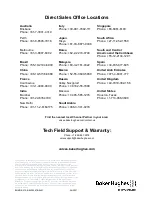
Masoneilan SVI3 Installation and Maintenance Manual
=
| 113
© 2021 Baker Hughes Company. All rights reserved.
Table 22 lists some compliance voltage readings at positioner terminals at several
currents.
7.6 HART Physical Layer Compliance of the Control System
Communications to a SVI3 requires a HART
®
-
compliant communications loop. The
HART
®
protocol specifies the noise level, impedance requirements, and configuration of
the loop. The controller or output card of the control system must comply with the Physical
Layer Specification.
7.6.1 Impedance Constraints
HART
®
communication is based on the
talking
device generating an AC current
superimposed on the 4
-
20 mA control signal
.
Two frequencies are generated; 1200 Hz
representing the digital value
1
and 2200 Hz representing the digital value
0
.
The
listening
device responds to the voltage generated when the AC current flows through the loop
impedance. In order to generate a voltage from a current there must be impedance.
HART
®
Protocol requires that this impedance be at least 220 Ohms at the tone signaling
frequencies.
HART
®
compliant current sources are supplied with the correct impedance versus
frequency characteristic. In Non-Compliant Current Sources there may be a noise
reduction capacitor across the output that lowers the impedance at higher frequencies and
thus lowers the signaling voltage. To be certain that at least 220 Ohms of impedance is
presented by the current source a resistor can be added in series with the current source.
This reduces the effective compliance voltage of the current source by 20 mA times the
value of the series resistor
.
An added resistor is unnecessary during tests with high
impedance current calibrators such as the Altek Model 334 Loop Calibrator
.
7.6.2 Noise Constraints
HART
®
Communication depends on converting two frequencies (1200 and 2200 Hz) into
digital values
1
and
0
.
Noise can cause errors in the conversion. Conventional good wiring
practice, such as use of twisted shielded pair cable with the shield grounded at only one
point, minimizes the effects of noise.
Table 22: Expected Voltage Range at Positioner Terminals
Current
Compliance Voltage
Requirement at
Positioner Terminals
Expected Voltage Measured at
Positioner Terminals
4 mA
11 V
10 to 11 V
8 mA
10.5 V
9.5 to 10.5 V
12 mA
10 V
9 to 10 V
16 mA
9.5 V
8.5 to 9.5 V
20 mA
9 V
8 to 9 V





































